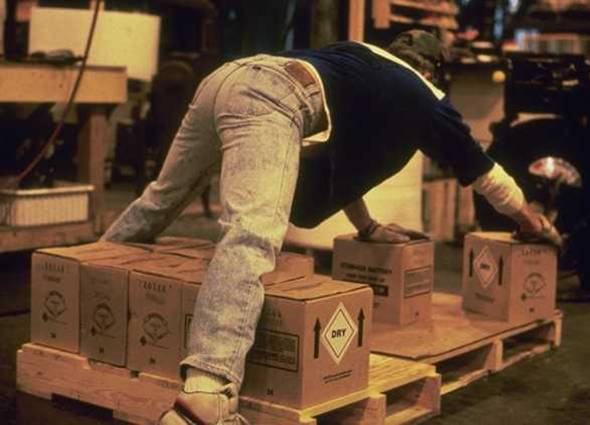 |
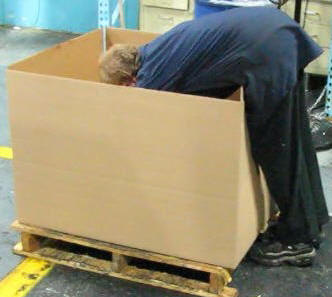 |
| Bending down to pallets and into containers | |
Principles affected
Related pages
Material handling
Background
Bending down into large containers or to pallets at floor level is extremely prevalent in manufacturing. This activity is a frequent source of back injuries as well as wasted time (see separate article Time Savings from Pallet Lifts, which quantifies the wasted time associated with lifting). Additionally, it is not uncommon for product damage to occur because of the difficulty in controlling the movement of materials while working in awkward postures, especially with heavy loads.
Objectives
Raise or orient the materials so that they are accessible with minimal bending and reaching.
(In other words, the point is to put materials at a good height, not necessarily to buy any particular piece of equipment. A nice, adjustable-height powered lift that is not used correctly is not ergonomic. In contrast, anything that makes the material accessible without needing to bend or reach is ergonomic, even if it is something simple and already available.)
Ideas and Options
There is a huge variety of options to raise and orient materials, ranging from inexpensive homemade stands up to high end variations. Because this issue is so widespread in industry, a large number of vendors provide equipment for this purpose. The vendor websites themselves provide a great deal of additional information (see list at bottom of this page).
Unfortunately, there is little standardization in terminology for many of the devices listed below. Terms like scissors lifts, pallet lifts, palletizers, pallet jacks, stackers, etc. can all mean the same thing or different things, depending upon the user, the plant, the industry, or the vendor. The following photos should help make the differences clear.
Fixed height stands
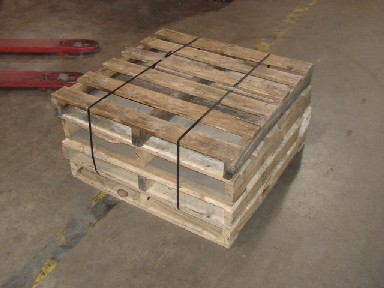 |
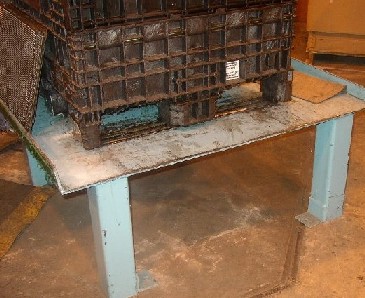 |
| Stack of pallets secured with metal shipping straps | Homemade knee-high container stand |
The least expensive approach is to simply create a stack of whatever materials are at hand to raise the items to be lifted to a better height. It is common for employees to spontaneously create these stacks, which can be perfectly fine in the right circumstances. Often it is better to replace makeshift stacks with something that is more substantial, such as a sturdy table or platform. The point is that it is not necessary to have height adjustability in order to obtain a good benefit.
Primary advantages — Inexpensive and can be created from existing materials or easily home made. The best application is to raise items that are short, roughly 2 ft. (50 cm) or less from top to bottom.
Primary disadvantages — If the items placed on these stands are too tall, the higher portions may be beyond reach. The stands can be instable and unsafe if they are too rudimentary.
Common error — Using fixed height stands for stacks of items that are too tall and thus too high to reach.
Spring-loaded (coil springs)
 |
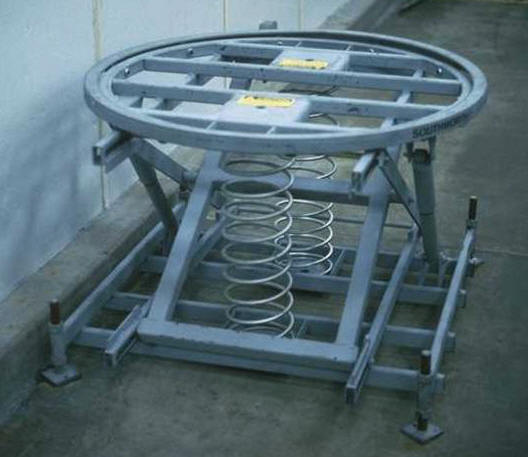 |
| Cafeteria trays on spring lifts | Coil spring lift with turntable |
The concept of using springs to lift materials has been used for decades in cafeterias to lift trays and plates — as one tray is removed, the next one springs into place. The same technique can be used in industrial operations, sometimes called “levelers” or “self-leveling lifts”. As items are placed onto the spring-loaded lift, it drops down. As the items are removed, it rises back up. The height at which the items are handled remains more or less the same.
Primary advantages — Relatively inexpensive, compared to the higher cost options listed below. The best use is for heavy items that are always about the same weight.
Primary disadvantages — A lift truck is generally required to place or remove a loaded pallet/container. When items of a different weight are handled, it may be necessary to change the springs, which can be cumbersome.
Common error — Handling stacks of items that are too tall and thus too high to reach when placed on the lift.
Spring-loaded (air spring)
 |
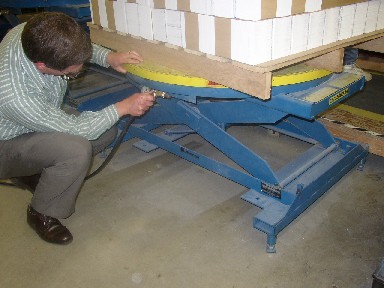 |
| Air spring lifts with turntables | Using air hose to adjust tension |
A variant of the spring-loaded lift uses an air spring, which has become popular because the tension can easily be changed to handle items of different weights. An ordinary compressed air hose (“shop air”) is used to pump air into the spring when a heavier item is to be loaded onto the lift. When switching to a lighter weight item, it is easy to bleed out some air manually, much the same as a car or bicycle tire.
Primary advantages — Less expensive than powered lifts, but more adjustable than coil springs.
Primary disadvantages — A lift truck must be used to place or remove loaded pallets/containers.
Common error — Stacks of items that are too high.
Manual pumps
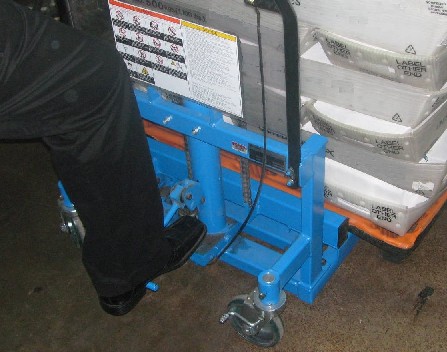 |
| Foot pedal to adjust height |
Some styles of adjustable-height lifts are raised with a manual foot or hand pump. These styles can provide good value in certain circumstances, primarily where the lift does not need to be adjusted frequently.
Primary advantages — Enables precise adjustment of height, compared to springs. Less expensive to buy than powered versions shown below.
Primary disadvantages — Requires the employee to stop work and move to a different side of the pallet to use the pump, thus wasting time, especially in high volume operations. The repetitive leg or arm motions can increase the risk of a musculoskeletal disorder if used too frequently. Because of the extra steps and effort, employees may conclude that the lifts are more trouble than they are worth, and not use the feature.
Common error — It can be short-sighted to purchase the manual pump versions instead of powered versions.
Powered lifts
 |
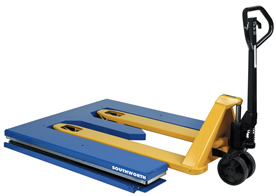 |
| Powered hydraulic lift with remote control | Hydraulic lift shaped to enable use of pallet jack (www.southworthproducts.com) |
This option is the most standard type of lift for pallets and containers. Powered lifts are usually hydraulic but powered air versions are available.
Primary advantages — Easy use of a remote control to raise and lower the materials as needed to keep them at good work height. Some new styles enable the use of an ordinary pallet jack to load and unload (photo above right). Powered lifts can be quite large and able handle heavy loads. Powered lifts can be used as personnel lifts (see standing platforms).
Primary disadvantages — Adding power increases the cost compared to the options listed previously. The lifts are not easily moved and can block access to work areas behind the lifts (although casters can be added). The standard styles (photo above left) are incompatible with ordinary pallet jacks and require use of a lift truck.
Variations — Casters can be added for mobility. Ramps can be added to enable use of pallet jacks (although usually requiring increased manual force to push the pallet jack up the ramp).
 |
 |
| Sliding surface (see video clip) | |
A relatively new variant is a surface that slides laterally to help bridge gaps between the lift and other surfaces. In the retracted position, passageway is ample.
Turntables
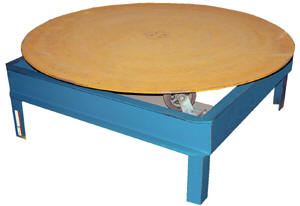 |
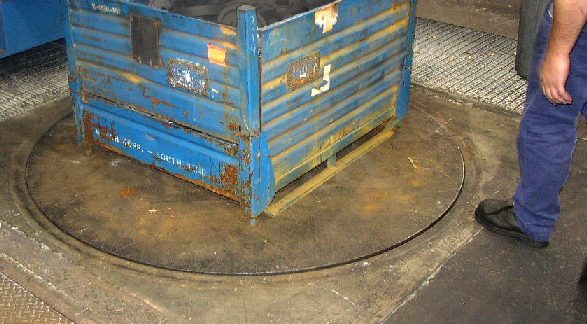 |
| Turntable on fixed-height stand (www.vestilmfg.com) | Turntable recessed into floor |
A feature that can be added to most of the above styles of lifts is a turntable. The photo directly above shows a turntable on a fixed-height stand. Other previous photos also show turntables in use.
Primary advantages — Reduces the need to reach across a pallet or container to handle items on the far side.
Primary disadvantages — More floor space is needed to accommodate the corners of the pallet or container. Containers must be of a design that permit access from more that one side
Floor-flush lifts
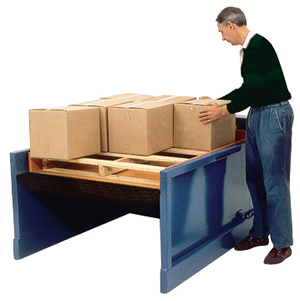 |
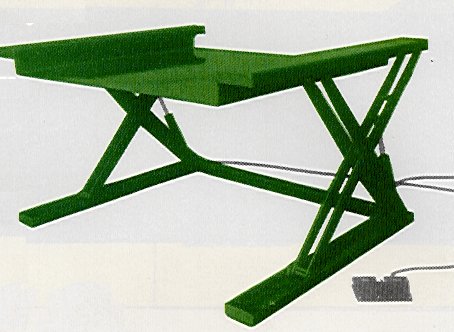 |
| Two styles of floor-flush lifts Southworth andwww.americanlifts.com | |
Several styles of lifts put the lift surface flush with the floor as a different approach that permits use of ordinary pallet jacks.
Primary advantage — Loading and unloading the lifts does not require a fork lift truck or any piece of equipment more complicated than an standard pallet jack.
Primary disadvantages — The power mechanisms on some designs are located on the sides or rear of the lift, which can require more floor space and increase the reach when loading and unloading (although newer designs have thinner sides, which reduces reach and floor space). At present there are fewer choices in size and capacity.
Recessed into floor
 |
| Hydraulic lift recessed into floor |
The lifts can be recessed into the floor, enabling materials to be rolled on and off.
Primary advantages — Ordinary pallet jacks can be used with ease. The lift can be recessed considerably lower than the floor to accommodate very tall stacks of materials. The lift is not in the way when not in use.
Primary disadvantages — High cost of cutting a hole into the floor. Inflexibility once the hole has been cut.
Post Lifts
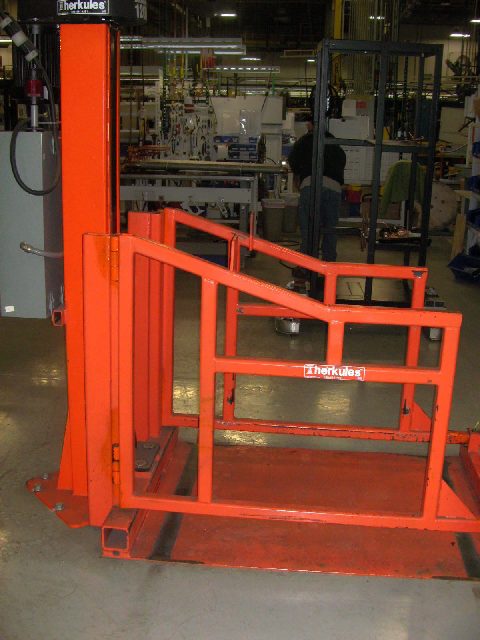 |
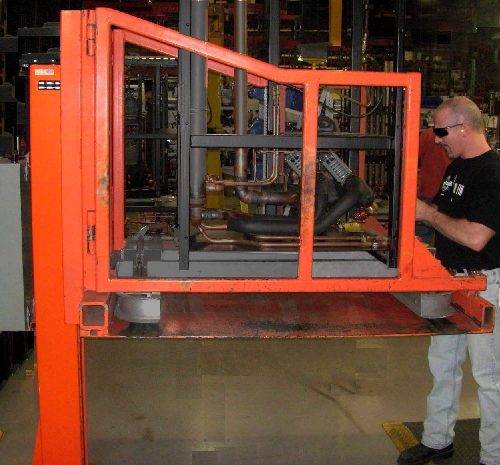 |
| Down position: flush with floor to roll on a cart or dolly | Up position: product is at good work height |
Post lifts provide an alternative style of a powered lift. The primary advantage is that that the loads can be raised higher than with an equivalent scissors lift, yet are floor flush. The post also provides more clearance to access the work.
 |
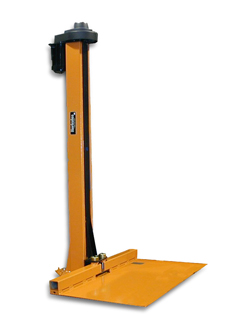 |
| Post lifts, cart positioner (left) and pallet positioner (right)www.herkules.us | |
Overhead lifts
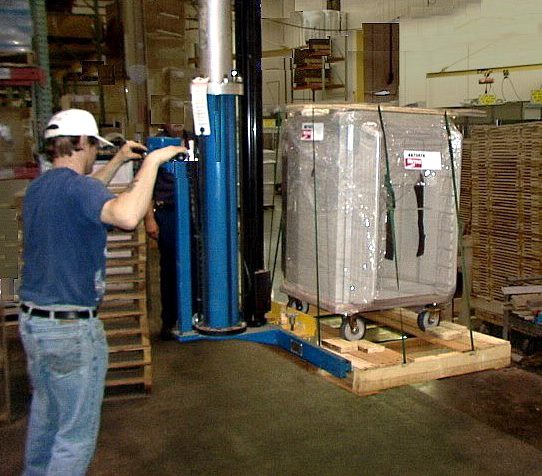 |
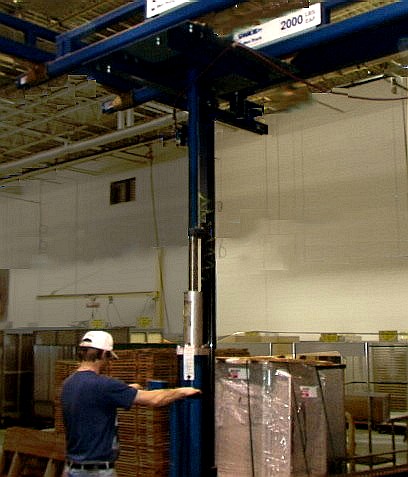 |
| Overhead lift suspended from gantry crane | |
Powered lifts can be mounted from overhead, as shown in the above photos.
Primary advantages — The lift can be used to move a pallet or container from one location to another, in addition to providing height adjustment. The lift can be moved out of the way to provide good access to the work area.
Primary disadvantages — Expense. Lateral movement is generally restricted to a relatively small work area.
Portable lifts (combination transport and lift)
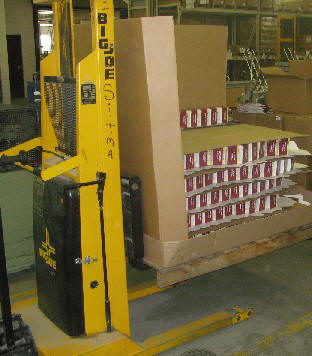 |
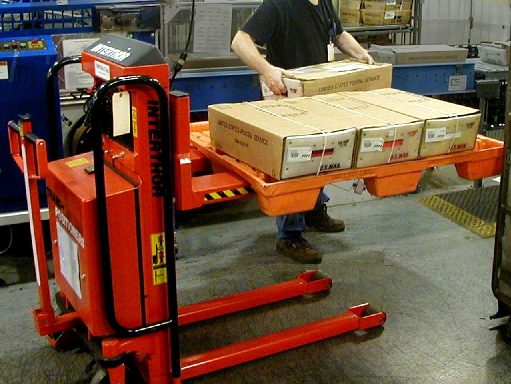 |
| Combination transporter and powered lift | |
These devices combine the functions of both a pallet jack and a power lift. In the low position, the device is manually pushed in the same way as a standard pallet jack. When in position, the pallet or container can be powered up or down as needed to optimize the handling height.
Primary advantages — Eliminates the need to buy both a pallet jack and a powered lift. In many plants, these devices enable employees to switch pallets and containers without needing to wait for a forklift truck. The portability enables the lift to be moved out of the way when not needed, and thus provides access to work areas.
Primary disadvantages — Capacity is not as high as stationary lifts (although still good capacity: e.g. 3500 lbs.).
See lifter-transporters for more lightweight versions and a more detailed overview of these and similar devices. They are treated separately because they can combine the functions of a cart as well as a lift and are not easily classified into either of these categories. Furthermore, these combination lifts/carts are placed into a separate category because they provide such good ergonomic benefits and because their availability is not well known.
Lifts for carts and dollies
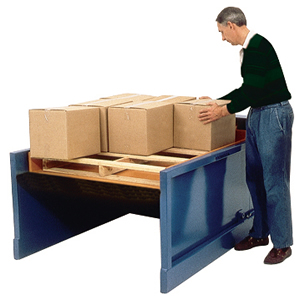 |
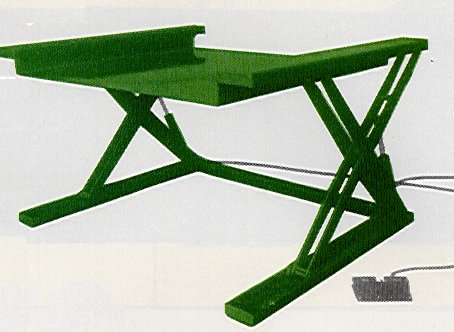 |
| Floor-flush lift used to raise cart | |
Carts and dollies can be lifted in several ways. One approach is to use floor flush lifts and roll the carts/dollies on, as shown above.
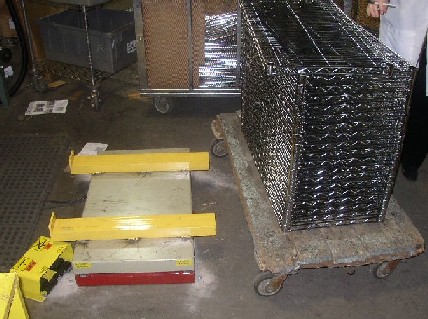 |
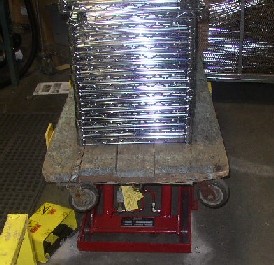 |
| Dolly rolls on top of powered scissors lift (slightly modified) | |
Another approach is to use a powered lift that is small enough to roll over. Note in the above photo that the lift surface has been modified for better stability.
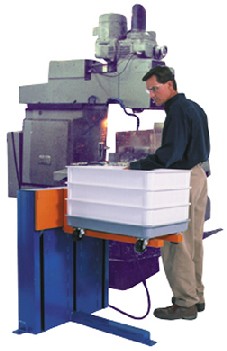 |
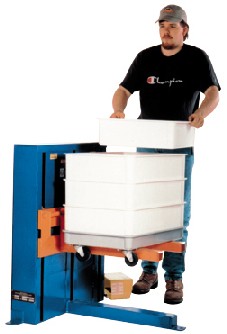 |
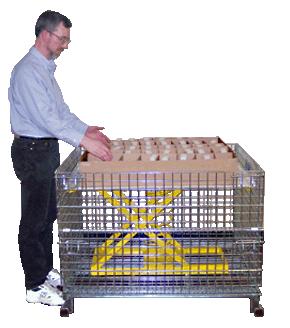 |
| Side-mounted forks on power lift (www.southworthproducts.com) | Small scissors lift placed inside cage container (alsoSouthworth) | |
This commercially available device uses a tower-style power lift with small, side-mounted forks to lift the dollies. Right: Small lifts can be placed into containers to ease loading and unloading.
Stacking height and Lean Manufacturing
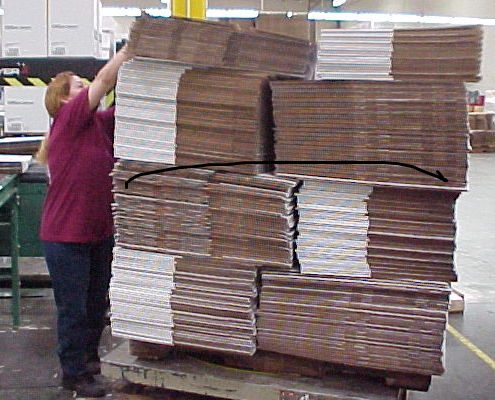 |
| High stack |
In the photo above, the stack of items is obviously very high. Sometimes it is necessary to stack this high, such as when the materials are going to be loaded onto a truck to be shipped a long distance or stored for a long time (that is, when it is important to “cube out” the space and get as much product as possible into an area.) However, in the above situation, the stack is only going to be moved a short distance within the same department, where it will be unstacked almost immediately and loaded into a machine. In this case, the stack does not need to be so high.
Often, the reason that products are stacked so high is simply a habit of trying to cram as many items as possible into a container or space of any type. This habit stems from the old days, when the philosophy was to have as many items on hand as possible. In contrast, today’s concepts of Lean Manufacturing emphasize having only as many items on hand as needed for efficient flow. Items do not need to be overly packed or stacked. In this sense, Lean Manufacturing makes the use of good ergonomics much easier.
Operations where lifts are often not feasible
 |
 |
| Warehouse racks | Shipping — many sort pallets |
Adjustable-height lifts can provide great value, but experience has shown that there are applications where the lifts are generally not feasible. Two examples are:
- Racks in distribution centers and warehouses — The additional space and number of lifts needed can be prohibitive, although sometimes feasible for especially heavy, awkward, or high volume items.
- Shipping (when products at the end of a production line are sorted onto multiple pallets or containers for shipping to different locations) — When a large number of sorts are required, it can be very difficult to provide a lift for each pallet or container.
Typically, space and congestion are constraints. Also, the number of items placed on each pallet or container can be small, thus eliminating the positive cost-benefit ratio associated with providing lifts.
Common vendors
www.southworthproducts.com
www.vestilmfg.com
www.autoquip.com
www.bishamon.com
www.interthor.com
www.liftrite.com
www.prestolifts.com
www.bigjoemfg.com
www.ergocart.com
www.liftproducts.com
www.prestolifts.com
See vendor information.
More examples
Fixed-height
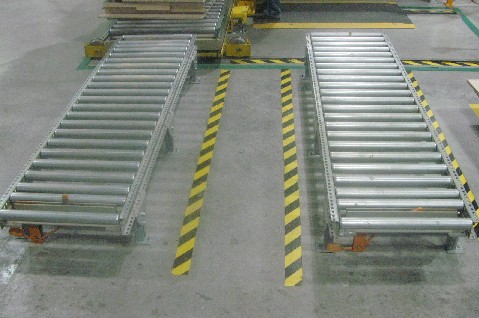 |
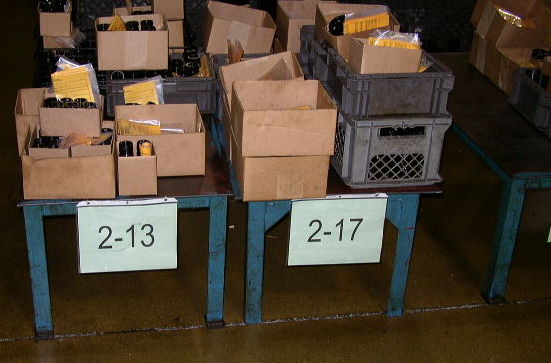 |
| Dual lengths of fixed-height conveyors, used to transfer items from one pallet to another | Multiple stands — Eliminates the need to bend to pick small items from the boxes |
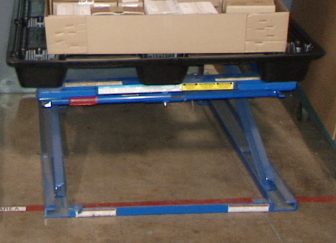 |
| Commercially available fixed-height stand that can be positioned at low, medium, and high levels |
Simple fixed height
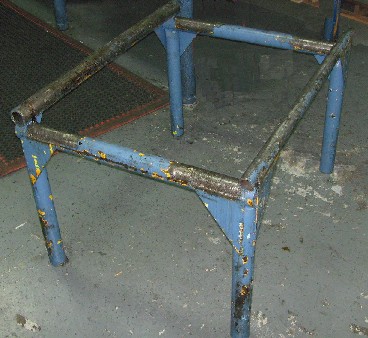 |
 |
Fixed-height stand homemade with pipe to raise container to good working height
Recessed
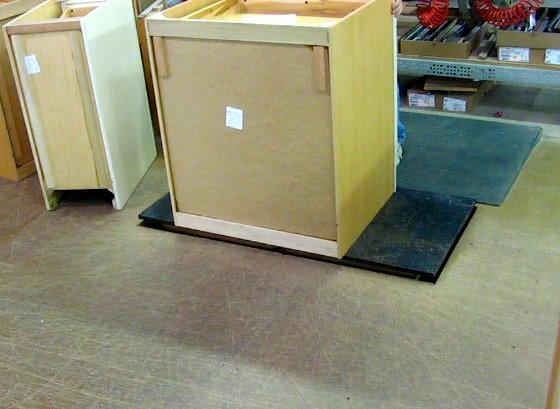 |
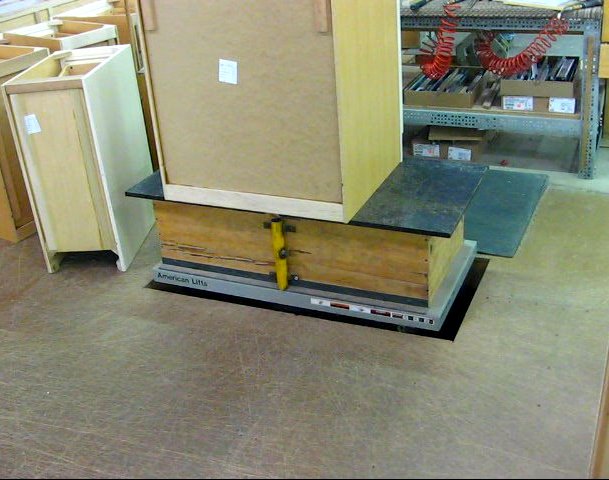 |
| Lift recessed into a large work area platform | |
Multiple
 |
| Multiple power lifts for a packing line |
